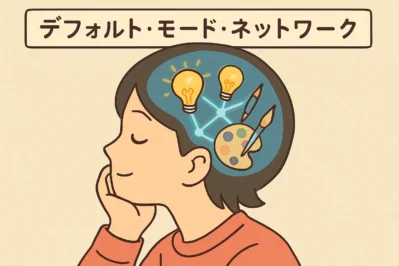Brainy Chats: Discuss the DMN & Creativity in Korean
Hello! This is Maeil Hangul (Daily Korean), here to upgrade your Korean skills to a whole new level!
Ever wanted to move beyond small talk and dive into deeper, more intellectual conversations in Korean? Today, we’re equipping you with the language to do just that. We’ll be exploring a fascinating topic from neuroscience: the role of the Default Mode Network (DMN) in creative thinking.
Lately in Korea, there’s a huge boom in self-development content related to brain science (뇌과학). From best-selling books to viral YouTube videos, people are fascinated by how to “hack” their brains for better focus and creativity. By learning today’s expressions, you’ll be able to join these high-level conversations and impress your Korean friends with your intellectual prowess. Let’s get started!
Core Expressions for Your Brainy Chat
Here are the essential terms you’ll need to discuss the creative brain like a native speaker.
1. 디폴트 모드 네트워크 (Default Mode Network)
- Pronunciation [Romanized]: Di-pol-teu Mo-deu Ne-teu-wo-keu
- English Meaning: Default Mode Network (DMN)
- Detailed Explanation: This is the direct Korean transliteration of the English term. The DMN is a network of brain regions that is most active when you are not focused on the outside world, like when you’re daydreaming, mind-wandering, or “spacing out.” It’s a technical term, and using it correctly immediately signals your advanced proficiency in the subject.
2. -와/과 밀접한 관련이 있다 (-wa/gwa miljeophan gwallyeon-i itda)
- Pronunciation [Romanized]: -wa/gwa mil-jeop-han gwal-lyeon-i it-da
- English Meaning: To be closely related/linked to ~
- Detailed Explanation: This is a sophisticated and formal way to say something is “closely connected to” something else. It’s perfect for academic or analytical discussions. Remember to use -와 after a vowel and -과 after a consonant.
- Example: 창의성과 밀접한 관련이 있다 (It is closely related to creativity).
3. 가설을 세우다 (gaseor-eul se-uda)
- Pronunciation [Romanized]: ga-seor-eul se-u-da
- English Meaning: To form/establish a hypothesis
- Detailed Explanation: This is a key phrase for any scientific or theoretical discussion.
가설means ‘hypothesis’ and세우다means ‘to set up’ or ‘to establish.’ When you want to propose a theory or an educated guess, this is the perfect expression.- Example: 저는 이런 가설을 세워 봤어요. (I’ve established a hypothesis like this.)
4. 통찰을 얻다 (tongchar-eul eot-da)
- Pronunciation [Romanized]: tong-char-eul eot-da
- English Meaning: To gain an insight; to have an epiphany / “Aha!” moment
- Detailed Explanation:
통찰(tongchal) means ‘insight’ or ‘penetration.’ This phrase beautifully captures the moment of sudden understanding or the spark of a brilliant idea. It’s much more profound than simply saying아이디어가 떠오르다(an idea comes to mind) and is often used to describe breakthroughs that happen when the DMN is active.
Example Dialogue
Let’s see how these expressions work in a real conversation. Here, Min-jun and Ji-hye are discussing a book on brain science.
민준 (Min-jun): 요즘 ‘뇌과학’에 관한 책을 읽고 있는데, 정말 흥미로워요. 특히 디폴트 모드 네트워크에 대한 부분이 인상 깊었어요.
I’ve been reading a book on ‘brain science’ lately, and it’s fascinating. The part about the Default Mode Network was particularly impressive.
지혜 (Ji-hye): 아, 저도 들어봤어요. 우리가 아무것도 안 하고 ‘멍때릴’ 때 활성화되는 뇌 영역 맞죠? 그게 창의성과 밀접한 관련이 있다면서요?
Oh, I’ve heard of that. It’s the brain region that activates when we’re ‘spacing out’ and doing nothing, right? I heard it’s closely related to creativity.
민준 (Min-jun): 맞아요. 그래서 저는 이런 가설을 세워 봤어요. 요즘 인기 웹툰 작가님들이 무의식적으로 이 네트워크를 잘 활용해서 계속해서 새로운 아이디어를 얻는 게 아닐까 하고요.
Exactly. So, I’ve formed a hypothesis: that popular webtoon artists these days might be unconsciously using this network well to continuously get new ideas.
지혜 (Ji-hye): 일리 있는 말이네요. 집중해서 고민할 때보다 오히려 샤워하거나 산책할 때 번뜩이는 통찰을 얻는 경우가 많잖아요. 그게 다 DMN 덕분이었군요.
That makes sense. We often gain a sudden insight while showering or taking a walk, rather than when we’re focusing hard. So that was all thanks to the DMN.
Culture Tip & Trend Deep Dive: The Art of “멍때리기”
In Korea, the act of spacing out is called 멍때리기 (meong-ttae-ri-gi). For a long time, it was seen as lazy or unproductive. However, that perception is changing dramatically!
Now, 멍때리기 is being re-evaluated as an essential activity for mental rest and, you guessed it, creativity. This cultural shift aligns perfectly with the scientific understanding of the 디폴트 모드 네트워크. There are even public “Space-Out Competitions” (멍때리기 대회) in Seoul where contestants compete to see who can do absolutely nothing for the longest time without falling asleep or checking their phone!
So, next time you’re discussing the DMN, you can mention the 멍때리기 trend. It shows you not only understand the science but also the modern Korean cultural context that embraces it. You’ll sound like a true insider!
Let’s Wrap It Up & Practice!
Fantastic job today! You’ve learned how to discuss a complex scientific topic in Korean using advanced vocabulary: 디폴트 모드 네트워크, ~와/과 밀접한 관련이 있다, 가설을 세우다, and 통찰을 얻다.
Now, let’s put your knowledge to the test.
1. Fill in the blank:
창의적인 문제 해결은 때로 깊은 사색을 통해 _________ 과정에서 이루어진다.
(Creative problem-solving is sometimes achieved in the process of _________ through deep contemplation.)
Hint: to gain an insight
2. Make a sentence:
Using the grammar ~와/과 밀접한 관련이 있다, create a sentence explaining the relationship between sleep and physical recovery.
Ready to challenge yourself? Try discussing a complex topic you’re passionate about in the comments below using today’s expressions! We’d love to see what you come up with.






